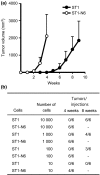Xenotransplantation elicits salient tumorigenicity of adult T-cell leukemia-derived cells via aberrant AKT activation
- PMID: 26928911
- PMCID: PMC4970830
- DOI: 10.1111/cas.12921
Xenotransplantation elicits salient tumorigenicity of adult T-cell leukemia-derived cells via aberrant AKT activation
Abstract
The transplantation of human cancer cells into immunodeficient NOD/SCID/IL-2Rγc(null) (NOG) mice often causes highly malignant cell populations like cancer stem cells to emerge. Here, by serial transplantation in NOG mice, we established two highly tumorigenic adult T-cell leukemia-derived cell lines, ST1-N6 and TL-Om1-N8. When transplanted s.c., these cells formed tumors significantly earlier and from fewer initial cells than their parental lines ST1 and TL-Om1. We found that protein kinase B (AKT) signaling was upregulated in ST1-N6 and TL-Om1-N8 cells, and that this upregulation was due to the decreased expression of a negative regulator, INPP5D. Furthermore, the introduction of a constitutively active AKT mutant expression vector into ST1 cells augmented the tumorigenicity of the cells, whereas treatment with the AKT inhibitor MK-2206 attenuated the progression of tumors induced by ST1-N6 cells. Collectively, our results reveal that the AKT signaling pathway plays a critical role in the malignancy of adult T-cell leukemia-derived cells.
Keywords: Adult T-cell leukemia; proto-oncogene protein Akt; severe combined immunodeficient mice; tumor-initiating cells; xenotransplantation.
© 2016 The Authors. Cancer Science published by John Wiley & Sons Australia, Ltd on behalf of Japanese Cancer Association.
Figures




References
-
- Matsuoka M, Jeang KT. Human T‐cell leukaemia virus type 1 (HTLV‐1) infectivity and cellular transformation. Nat Rev Cancer 2007; 7: 270–80. - PubMed
-
- Kfoury Y, Nasr R, Journo C, Mahieux R, Pique C, Bazarbachi A. The multifaceted oncoprotein Tax: Subcellular localization, posttranslational modifications, and NF‐κB activation. Adv Cancer Res 2012; 113: 85–120. - PubMed
MeSH terms
Substances
LinkOut - more resources
Full Text Sources
Other Literature Sources
Molecular Biology Databases
Research Materials

